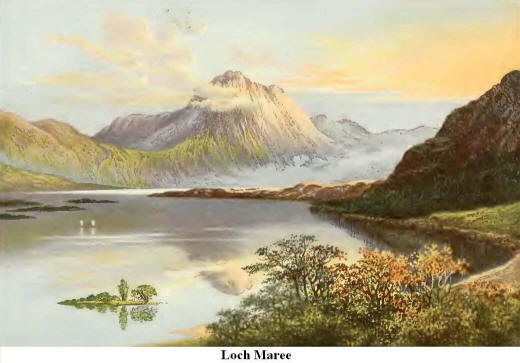|

The first sight of this glorious loch, as the stage coach from
Auchnashcen station brings the traveller to the top of a steep descent,
is calculated to excite the liveliest emotions of wonder and surprise
The road reminds one of some Alpine pass, while far below stretches the
large sheet of water, with its western end eighteen miles away. If for a
moment a feeling of the smallness of the loch should supervene, the huge
hills dwindling it down by their enormous bulk, this soon passes away,
and we feel to be in presence of one of Scotland's proudest lochs. The
coach drive to Gairloch occupies six hours in all, including a short
stoppage to bait the horses at Kinlochewe, and during the whole time the
eye is filled with pictures of grandeur or of delight. After the tedious
descent to the water's edge has convinced you that the feeling of
smallness is a mistake, yon have time to observe the effect which such a
mountain as Ben Slioch has in dwarfing all around it. Loch Maree is but
six miles from the sea, with no great descent, so that the hill raises
its mighty shoulders almost sheer from the sea level. From the road you
perceive, skirting the loch on the other side, what seems a fringe of
very small bushes. But anon a two-storey house appears among the bushes,
which now, with a known standard of comparison, are seen to be tall
trees! From the top of Ben Slioch, or any of the neighbouring mountains
of first-class size, the view is grand, embracing at once the Atlantic
and the German Oceans. On the opposite side from Ben Slioch is the
Scottish Pentelicus, Ben Eay, whose brilliant white quartz
pinnacle may sometimes be seen shining in the sun, like the famed marble
mountains of Greece. On the bosom of Loch Maree, near its widest end,
are several islands, the largest of which, Eilan Mhaolrubh, contains the
remains of an old chapel, and a holy well that is even yet in high
repute amongst the ignorant. It is sometimes said that the chapel,
island, and loch got their name from the Virgin Mary, but this is now
universally acknowledged amongst scholars to be an error. It was the
Irish preacher, Maclrubha, (Latinised to Malrubius, then softened down
in local tongues to Mulray, Mouric, and Marce,) who came over to
Scotland in the seventh century, who gave his name to the place. Dr.
Arthur Mitchell, in his Rhind Lectures on Civilization, has told in full
the story of the curious superstitions concerning this island, of which
examples as recently as twenty years ago are quoted. It is to be noted
that when, a year or two ago, the Queen visited the island, great
indignation was expressed in some quarters, because it was on a Sunday
evening she got rowed over from her retreat at Talladale to see this
interesting place.
The coach leaves the edge of the loch at Talladale, after a lovely and
varied drive along its banks, now in the bosom of a dense wood, now in
the midst of a rocky chaos,
'The fragments of an earlier world.'
A few miles down the road are found the romantic falls of the Kerry. The
man on the box seat at the left of the coach looks sheer down the
precipice over which the stream falls, as the coach with a swing turns
the corner of the steep road, with little visible between the traveller
and the dangers of that awful chasm!
Return to
Book Index page !
See our Gairloch and Loch Maree
page |
